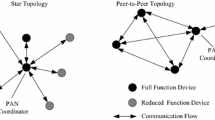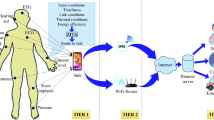Abstract
A Wireless body area network (WBAN) is a communication network that provides both medical and consumer electronics services by using sensors in/on/around a human body. In general, a WBAN environment suffers from frequent link loss due to interferences among sensors scattered over a body. In addition, the channel condition can frequently change by postural body movement, which increases packet drops, retransmissions, and eventually power consumption. This paper presents an Analytical Hierarchy Process (AHP)-based flexible relay node selection scheme that considers a multitude of decision factors, such as average SNR, remaining energy ratio, and traffic load. Moreover, the proposed scheme can adaptively satisfy the requirements of WBAN in various scenarios. Our simulation study shows that the proposed method provides high communication reliability and low power consumption.









Similar content being viewed by others
References
Milenkovic, A., Otto, C., & Jovanov, E. (2006). Wireless sensor networks for personal health monitoring: Issues and an implementation. Computer Communications, 29(13–14), 2521–2533.
IEEE 802.15 WPAN Task Group 6 (TG6) Body area networks. http://www.ieee802.org/15/pub/TG6.html.
Zhen, B., Patel, M., Lee, S., Won, E., & Astrin, A. (2008). TG6 technical requirements document (TRD), IEEE P802.15-08-0644-05-0006.
(2012). IEEE standard for local and metropolitan area networks—Part 15.6: Wireless body area networks, IEEE Std 802.15.6-2012 (pp. 1–271).
Ma, Y., Kibria,R., & Jamalipour, A. (2008). Optimized routing framework for intermittently connected mobile ad hoc networks. In Proceedings of IEEE international conference of communication 2008 (ICC 2008) (pp. 3171–3175). Beijing.
Mehta, N., Duel-Hallen, A., & Wang, W. (2012). Enabling adaptive rate and relay selection for 802.11 mobile ad hoc networks. In Proceedings of IEEE international conference of communication 2012 (ICC 2012) (pp. 4150–4154). Ottawa.
Kim, J., & Lee, J. (2011). Opportunistic wireless network coding with relay node selection. EURASIP Journal on Wireless Communications and Networking, 2011(2011), 196.
Jing, T., Zhu, S., Li, H., Cheng, X., & Hou, Y. (2013). Cooperative relay selection in cognitive radio networks. In Proceedings of IEEE international conference on computer communications 2013 (INFOCOM 2013) (pp. 175–179). Turin.
Krikidis, I., Charalambous, T., & Thompson, J. S. (2012). Buffer-aided relay selection for cooperative diversity systems without delay constraints. IEEE Transactions on Wireless Communications, 11(5), 1957–1967.
Zhang, S., & Lau, V. K. N. (2011). Multi-relay selection designed and analysis for multi-stream cooperative communications. IEEE Transactions on Wireless Communications, 10(4), 1082–1088.
Song, L. (2011). Relay selection for two-way relaying with amplify-and-forward protocols. IEEE Transactions on Vehicular Technology, 60(4), 1954–1959.
Elrabiei, S. M., & Habaebi, M. H. (2010). Energy efficient cooperative communication in single frequency networks. In Proceedings of IEEE annual international symposium on personal, indoor, and mobile radio communications 2010 (PIMRC 2010) (pp. 1719–1724). Istanbul.
Tuah, N., & Ismail, M. (2013). Extending lifetime of heterogeneous wireless sensor network using relay node selection. In Proceedings of international conference on information and communication technology 2013 (ICoICT 2013) (pp. 17–21). Bali.
de Graaf, M. (2013). Energy efficient networking via dynamic relay node selection in wireless networks. Elsevier Ad Hoc Networks, 11(3), 1193–1201.
Ehyaie, A., Stachyra, M., & Khadivi, P. (2009). Using relay network to increase life time in wireless body area sensor networks. Proceedings of IEEE international symposium on a world of wireless, mobile and multimedia networks 2009 (WoWMoM 2009) (pp. 1–6). Kos.
Reusens, E., Joseph, W., Latre, B., Braem, B., Vermeeren, G., Tanghe, E., et al. (2009). Characterization of on-body communication channel and energy efficient topology design for wireless body area networks. IEEE Transactions on Information Technology in Biomedicine, 13(6), 933–945.
Elias, J., & Mehaoua, A. (2012). Energy-aware topology design for wireless body area networks. In Proceedings of IEEE international conference of communication 2012 (ICC 2012) (pp. 3409–3413). Ottawa.
Lin, C., & Chuang, P. (2013). Energy-efficient tow-hop extension protocol for wireless body area networks. IET Wireless Sensor Systems, 3(1), 37–56.
Saaty, T. L. (2000). Fundamentals of decision making and priority theory with the analytic hierarchy process. Pittsburgh, PA: RWS Publications.
Varga, A. (2001). The OMNeT++ discrete event simulation system. In Proceedings of European simulation multiconference 2001 (ESM 2001) (pp. 319–324). Prague.
(2012). IEEE standard for local and metropolitan area networks–Part 15.4: Low-rate wireless personal area networks (LR-WPANs) Amendment 1: MAC sublayer. IEEE Std 802.15.4e-2012 (Amendment to IEEE Std 802.15.4-2011) (pp. 1–225).
Heinzelman, W. R., Chandrakasan, A., & Balakrishnan, H. (2000). Energy-efficient communication protocol for wireless microsensor networks. In Proceedings of Hawaii international conference on system sciences 2000 (HICSS 2000) (pp. 3005–3014). Maui.
Acknowledgments
This research was supported by Basic Science Research Program through National Research Foundation (NRF) of Korea funded by the Ministry of Education (NRF-2013R1A1A2059741).
Author information
Authors and Affiliations
Corresponding author
Rights and permissions
About this article
Cite this article
Kim, B., Cho, J., Jeon, S. et al. An AHP-Based Flexible Relay Node Selection Scheme for WBANs. Wireless Pers Commun 89, 501–520 (2016). https://doi.org/10.1007/s11277-016-3284-y
Published:
Issue Date:
DOI: https://doi.org/10.1007/s11277-016-3284-y




